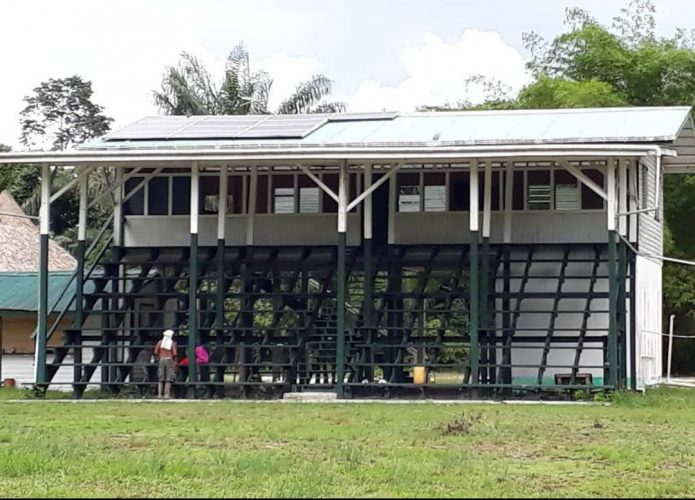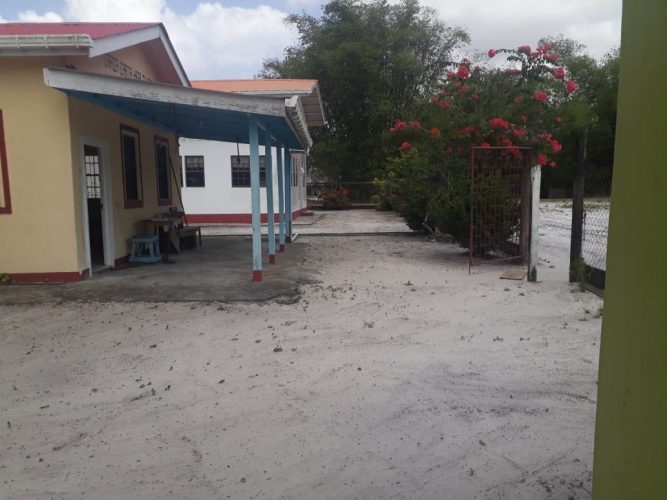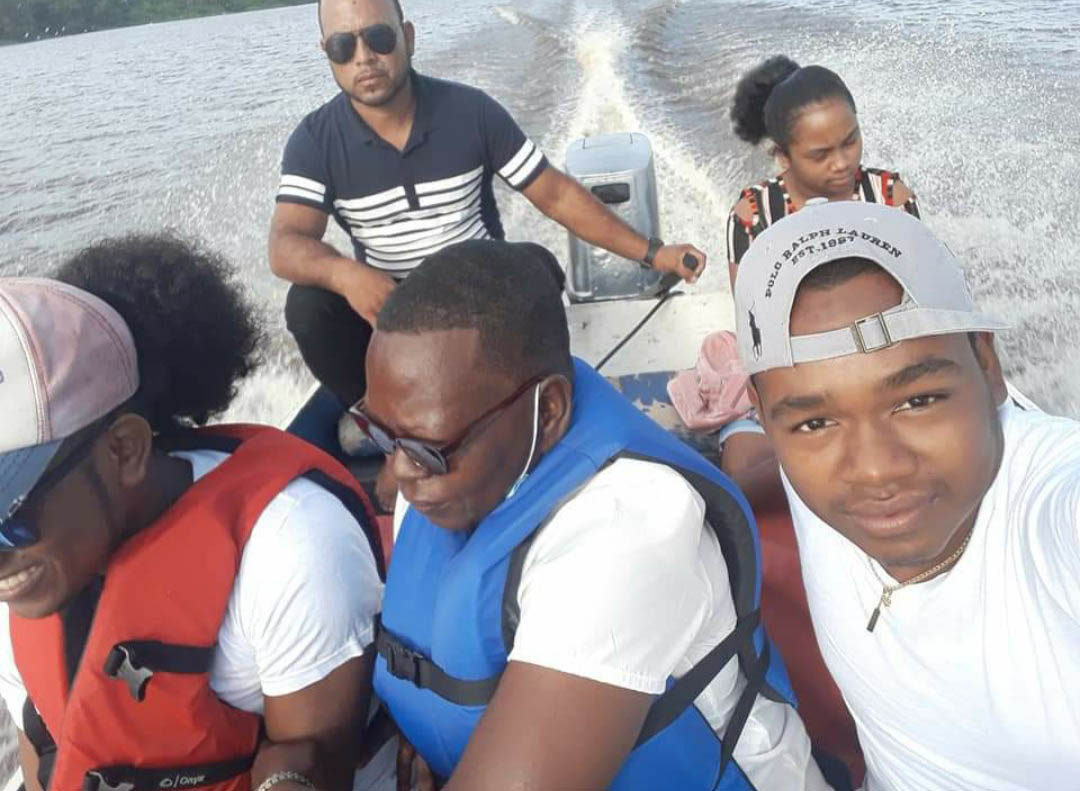Although poverty forced her to drop out of school when she was in second form, community health worker (CHW) and activist Everly Klass-Sampson has gone on to pursue her dreams of building her adopted community of Caria Caria in the Essequibo River into a healthy and socially strong one.
A community health post, a community centre and a playfield are among structures in the community that stand as testimony to Klass-Sampson’s determination.
The seventh child of 10 siblings, Klass-Sampson, now 47, was born at Buck Hall on the Essequibo River, and grew up in a relatively poor environment.

“We were so poor I had to drop out of Fredricksburgh Secondary School in Wakenaam while in Form Two. At that tender age, I stayed with my dad’s great aunt who was very old. I cooked for myself. I had one set of school clothes that I had to wash every afternoon to wear the next day. My mom would buy two pints of rice, two pounds of flour, $20 aji, a pint of kero and quarter pint of cooking oil or coconut oil, to last for the week. We lived at the back of Wakenaam on the side facing Leguan. I had to walk about five miles through different villages from Fredricksburgh to Belle Plaine and back again every Saturday to collect my ration. Sometimes I got a drop with a tractor,” she told Stabroek Weekend.
Being unable to maintain this routine, she dropped out of school.

Her mother, the main breadwinner for the family, would buy and sell ground provision at Bartica. “My father was an alcoholic who spent all the money he earned on alcohol. He literally drank himself to death.”
Instead of book bags, they would make “strap slings,” using strings tied together to hold their books, which they slung over their shoulders. Sometimes, they depended on charity for survival.
After dropping out of school, Klass-Sampson returned to Buck Hall, where she stayed for two years before going to live with an aunt in Georgetown. Later, when her father died, she returned to Buck Hall to help her mother. “By then my mother was a bit older and she had stopped trading. So my smaller brother and I had to do a bit of farming, cut with an axe wallaba posts to sell, cut firewood in small pieces and put them in bundles and paddle with that to Wakenaam to sell to get money for the house.”
Becoming a health worker
So how did Klass-Sampson become a community health worker and find employment with the Department of Health of Region Three?
In 1988, the Region Three administration was looking for someone to replace her sister-in-law, who was initially identified for the CHW training and who was heavily pregnant at the time and could not undertake the training. Klass-Sampson was asked to fill the breach but felt inadequate because she had not completed her secondary education.
The medex in charge of the recruitment asked her to do a test. She told her if she scored over 13 out of 25 marks she would be eligible. She scored 15 out of 25.
She was part of a batch of 35 trainees from the hinterland regions who undertook the five-month training programme at the Kumaka District Hospital in Santa Rosa, Moruca. “I felt like I had gone back to school. It was a great learning opportunity for me. We did both practical and theory. It was challenging but thankfully a lot of it was practical so I also learnt by doing.”
There was no health centre in Caria Caria and she was trained to handle some of the services offered by one.
All the trainees were trained in first aid, and as care givers, which included how to care for the elderly, how to treat different minor sicknesses, how to diagnose certain illnesses, and how to deliver babies in cases of emergency, among other things.
“I am the first CHW or medical person to ever train to work in Caria Caria,” she said.
When she started working as the CHW, she had just gotten married to a man from Caria Caria. She had no place to work from.
“Because of what I had learned and the passion to execute my duties, I had to find my own accommodation. I begged for some materials from the old school building that was condemned. With that I enclosed the bottom of my little house, got two rooms and made my own health post where I worked for eight years.”
About a year into her work, she had to deliver a baby. Some persons cannot afford to go to the hospital at Suddie or West Demerara and they would do the delivery by themselves at home.
“I sat through the night until the next morning with my first patient. She was living in a camp. The delivery was safe. The child, a nephew of ex-president Donald Ramotar, is now 21 years old.”
She does not encourage persons to deliver at home because she is not a trained midwife. “You never know when there could be a complicated case. When it happens and I don’t have a choice, I assist.” To date she has delivered 12 babies.
Once a man came out of the interior on a stretcher very sick with dysentery, she said. She treated him at Caria Caria with Oral Rehydration Salts to which she added some sugar and salt, then took him to West Demerara Regional Hospital. When the doctor asked the man how he survived, he told the doctor how Klass-Sampson treated him.
On another occasion, she said, a young man came to her in the middle of the night with a bleeding head injury. She stemmed the bleeding and together with her husband, they took him in the middle of the night by boat on the Essequibo River to the Suddie Hospital.
The gratitude expressed by those she would have been obligated to help, she said, is enough reward for her efforts.
Community health post
When the village invited then Minister of Amerindian Affairs Carolyn Rodrigues-Birkett to look at the possibility of Caria Caria being declared an Indigenous Peoples community, Klass-Sampson said, she told her about her “own” health post she had built and of its inadequacies. Rodrigues-Birkett promised to assist. Two weeks later, Rodrigues-Birkett informed Klass-Sampson that $1.5 million had been allocated to build a health post in the community. It was subsequently built.
Klass-Sampson has her own boat and engine, which she has been using to do her work.
“For 22 years I have been using my boat and engine to transport people in emergencies.”
Her husband drives the boat. On two occasions at night, he had to go alone with the patients because she could not go.
“My husband is Amerindian and the police probably thought he was Brazilian. Once they locked him up for an hour with a pregnant patient, even though he explained he was taking the woman to Suddie Hospital.”
She gets no compensation for using her own means of transportation. The region provides her with 17 gallons of gas, 10 gallons of which is used on a return trip to Parika to take out monthly reports and to receive supplies. With the remaining seven gallons, she said, she might be able to visit neighbouring Buck Hall or Great Troolie Island.
Community work
Klass-Sampson, who has now lived in Caria Caria for 23 years, became a member of the Caria Caria Community Development Council (CCCDC), which started encouraging parents to send their children to secondary school.
“When I came to Caria Caria, children were only going to primary school which some did not complete. Region Three does not have schools with dorms. We asked for transfers for children to Region Two because it was closer and more affordable. Some children are placed at Aurora Secondary, Abram Zuil Secondary or Anna Regina Multilateral.”
About 23 students now attend secondary schools in Region Two. Her son, Quincy, is at Anna Regina Multilateral. When she takes him to school, she takes as many children as her boat could hold and when she collects him from school she does the same.
The acquisition of secondary education by community members, she said, is already seeing some success since a few who already wrote the Caribbean Secondary Education Certificate (CSEC) examinations are obtaining jobs outside of the community. Some are pursuing higher educational opportunities.
For the interested adults who did not get to go to a secondary school but wanted some higher education, Klass-Sampson said, “I was a part of the team that approached Aurora Gold Mines/Guyana Goldfields (AGM/GG) to provide adult education classes for us. They paid a retired headmaster to teach us Maths and English three times a week for two years. They paid for those writing the CSEC exams. We had good results.”
Klass-Sampson and her team also asked AGM/GG for a play park for the children which they were given, to host educational summer camps for children and adults and Christmas school parties for the children,
They also got AGM/Guyana Goldfields to do several medical outreaches at Caria Caria that involved other nearby islands like Western Hogg Island and Great Troolie Island.
Community centre and playfield
Klass-Sampson recalled when she first went to Caria Caria, the area was in high bush and people walked through a narrow track to reach from one place to another. With her brother, Compton Klass, also a resident, they got the people together to weed and clear and widen the track so children could walk safely to school.
When Klass-Sampson chaired the CCCDC, she said, one of the projects identified was a community centre. When the time came to look for funding to build it, some other CCCDC members did not see it as a priority.
“So I decided to work silently,” she said. One day at Parika, she saw the engineer for Region Two and another man she identified as a Mr Straker from the CDC head office in Georgetown. She introduced herself to Mr Straker.
“I made my case as to why we needed a community centre building. He said he was going to think about it. He asked me what size of building. I had no clue or knowledge about size so I said, I need a 75-feet building. He said, ‘I cannot promise you a 75-feet building but I can probably get you a building’.”
About two months later, she said, he called to say that $5 million had been allocated from his department but it would only cover a 45-feet building. She thanked him.
“Mr Straker visited Caria Caria and identified the spot. The community was aware that we were going to have a centre when the materials came in. People started saying the centre was going to be a white elephant but from the time the works were finished to now, it is being used. We used it for the two-year adult education classes, the HEYS (Hinterland Employment and Youth Services) programme, camps and even weddings. When the pandemic started and the children had to be separated, some were placed in the centre.”
Last year, AGM/GG completed the sanding and polishing of the floor of the community centre.
Noting that the young people in Caria Caria are involved in sports, particularly cricket, which is also used as a fund raiser for the community, in 2014, Klass-Sampson again approached AGM/GG which gave them $1 million to help fund the development of the playfield.
When she saw the sports minister at the time Dr Frank Anthony at a heritage activity at Karrau she told him that the young people in Caria Caria needed a playfield. He told her to submit a plan with an estimate as early as possible.
“I hadn’t the knowledge to do what he requested so I just wrote him a letter. His ministry gave us $1 million.” With the $2 million from AGM/GG and the Sports Ministry the playfield was built.
Klass-Sampson again approached AGM/GG to build the bleachers which is now attached to the community centre and overlooks the playfield.
Klass-Sampson was secretary for the CCCDC for 12 years but acted as its leader.
She enlisted the Guyana Red Cross Society to work with the CCCDC for eight months doing training in first aid, fire drills and community disaster relief. The community centre has been identified as a disaster relief centre.
At the end of eight months they provided the community health post with its current stock of furniture and other equipment that include a bed, stretcher, wheel chair, cupboards and reception desk.
COVID-19
To date, Caria Caria has had no case of COVID-19. To deal with the situation, Klass-Sampson engaged the Civil Defence Commission, which had set up a COVID-19 booth at Buck Hall. She asked for six young people from Caria Caria to be trained in raising awareness among the people on the dangers of the coronavirus, and to assist in manning the booth. At the home front Klass-Sampson continues to asked people to observe the COVID-19 safety protocols.
Noting that people are not travelling from Caria Caria except in emergencies, Klass-Sampson said, she assists pensioners and beneficiaries of public assistance in renewing their cheque books at Vreed-en-Hoop. “They authorize one of their younger relatives to withdraw their money at Parika and do their shopping for them.”
The proud mother of three children, Klass-Sampson is very involved in their extra-curricular activities and encourages them to get involved in helping others. Her son, Quintyn Sampson, 21, who is making a name for himself in cricket, also likes helping young people. Her younger son, Quincy, 17, is showing his strength in throwing the javelin.


